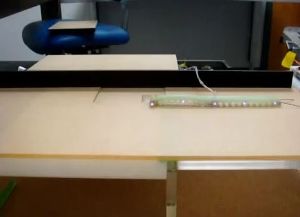The new generation of search and rescue soft robots is to be based on the diverse behavior of caterpillars. The present day soft bodied robots are extremely adaptable and flexible, but the one thing, which they lack, is speed which is what motivated the researchers to take a look at the terrestrial soft bodied animals.
To protect themselves from predators, some types of caterpillars are capable of speedily curling themselves in the shape of a wheel and then pushing themselves away from their enemies. This process is called ballistic rolling, and is purported to be the fastest wheeling behavior seen in nature.
 GoQBot
GoQBot
The caterpillar’s movements have been replicated by the researchers with the help of a 10cm soft bodied robot named GoQBot, which was fashioned out of silicone rubber and set in motion with the help of the embedded shape memory alloy coils. Its name came from the Q shape, which it takes before rolling away at a speed of almost half a meter per second. With a design specifically aping the functional morphologies of a caterpillar, it was mounted with five infrared emitters on its sides for motion tracking with one of the modern high speed three-dimensional tracking systems. At the same time, a force plate took measurements of the detailed ground forces even as the robot went into a ballistic roll.
Researchers found that the caterpillars don’t seem to often use the ballistic roll and this was attributed to the fact that the ballistic rolling could be accomplished only on smooth surfaces with a great deal of power. It could also end in an unpredictable manner. This study provides a great insight into the caterpillar’s escape system and at the same time offers a new locomotor strategy for future robotic development. Most of the modern robots are fashioned after worms, caterpillars and snakes, which exhibit talents in climbing into difficult and inaccessible spaces and also crawl. However, the speed of the robot is greatly reduced due to their limbless state. There are other robots that use a rolling motion for speed travel and efficiency, but cannot reach difficult spaces.
According to Huai-Ti Lin, from the Tufts University Department of Biology and lead author of the research paper, the GoQBot reconfigures its body and could thus improve many robotic applications such as building inspection, urban rescue and environmental monitoring. It could even be of use in disaster hit areas by wheeling into the area and wiggling its way into the danger.
Source: http://iopscience.iop.org/1748-3190/6/2/026007